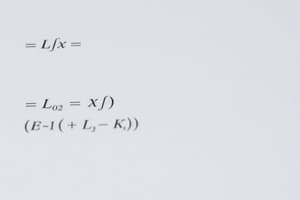Podcast
Questions and Answers
क्या एक लिमिट किसे पता लगाने की अनुमति देती है?
क्या एक लिमिट किसे पता लगाने की अनुमति देती है?
जब चीजें बहुत करीब आती हैं, लेकिन अभी भी अलग होती हैं।
कैलकुलस में डेरिवेटिव क्या होता है?
कैलकुलस में डेरिवेटिव क्या होता है?
यह एक कार्य है जो समय के साथ किसी चीज की तेजी को किसी अन्य मात्रा के साथ तुलना करता है।
इंटीग्रल्स किसे प्रस्तुत करते हैं?
इंटीग्रल्स किसे प्रस्तुत करते हैं?
यह तर्जियों के नीचे क्षेत्र की गणना करते हैं।
डिफरेंशियल्स क्या करते हैं?
डिफरेंशियल्स क्या करते हैं?
क्या डिफरेंशियल इक्वेशन्स क्या वर्णन करते हैं?
क्या डिफरेंशियल इक्वेशन्स क्या वर्णन करते हैं?
क्या कैलकुलस के संबंध में लिमिट्स का उपयोग क्यों किया जाता है?
क्या कैलकुलस के संबंध में लिमिट्स का उपयोग क्यों किया जाता है?
Flashcards
What does a Limit Reveal?
What does a Limit Reveal?
Helps determine what happens as things get very close, yet remain distinct.
What is a Derivative?
What is a Derivative?
A function that compares how fast something changes with respect to another quantity.
What do Integrals Represent?
What do Integrals Represent?
Integrals calculate the area under curves.
What do Differentials do?
What do Differentials do?
Signup and view all the flashcards
What do Differential Equations Describe?
What do Differential Equations Describe?
Signup and view all the flashcards
Why use Limits in Calculus?
Why use Limits in Calculus?
Signup and view all the flashcards
Study Notes
Calculus is a branch of mathematics that deals with continuous changes and rates of change. It involves studying limits, derivatives, integrals, and differentials. Here's some information on these key aspects of calculus:
Limits: A limit allows us to determine what happens to variables when they get very close together while still being distinct. For instance, if you have x going towards y, its limit could be considered zero. Limits are often used to define derivative functions.
Derivatives: In calculus, a function that gives us how fast something is changing over time, relative to another quantity is called a derivative. For example, consider the height of a sine wave over time; we might want to know how quickly it's growing or shrinking at any given moment. This would correspond to its first derivative, which tells us exactly where its peaks and troughs will occur along this curve.
Integrals: Integrals calculate the area under curves by taking small parts of them into account one after another until all areas between two points have been added up correctly. They can also represent accumulated values from past events, such as total costs or profits made during certain periods.
Differentials: If we give each point along a line segment a name so that we may refer back easily later on, those names become differential elements. Differential equations describe physical systems, like predicting speeds based on forces moving objects around paths determined by their velocities.
Calculus has numerous applications in fields beyond pure math itself - economics, physics, engineering, biology, and even philosophy rely heavily upon concepts derived from this discipline. So whether you're tracking stock market trends, designing bridges, understanding biological processes within living organisms, or pondering deep philosophical questions related to existence itself - understanding calculus can serve as an integral part of your journey!
Studying That Suits You
Use AI to generate personalized quizzes and flashcards to suit your learning preferences.
Description
Learn about key aspects of calculus including limits, derivatives, integrals, and differentials. Understand how these concepts help in studying continuous changes, rates of change, and predicting behaviors of various functions and systems.



